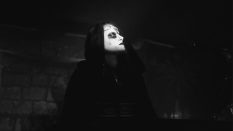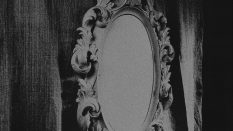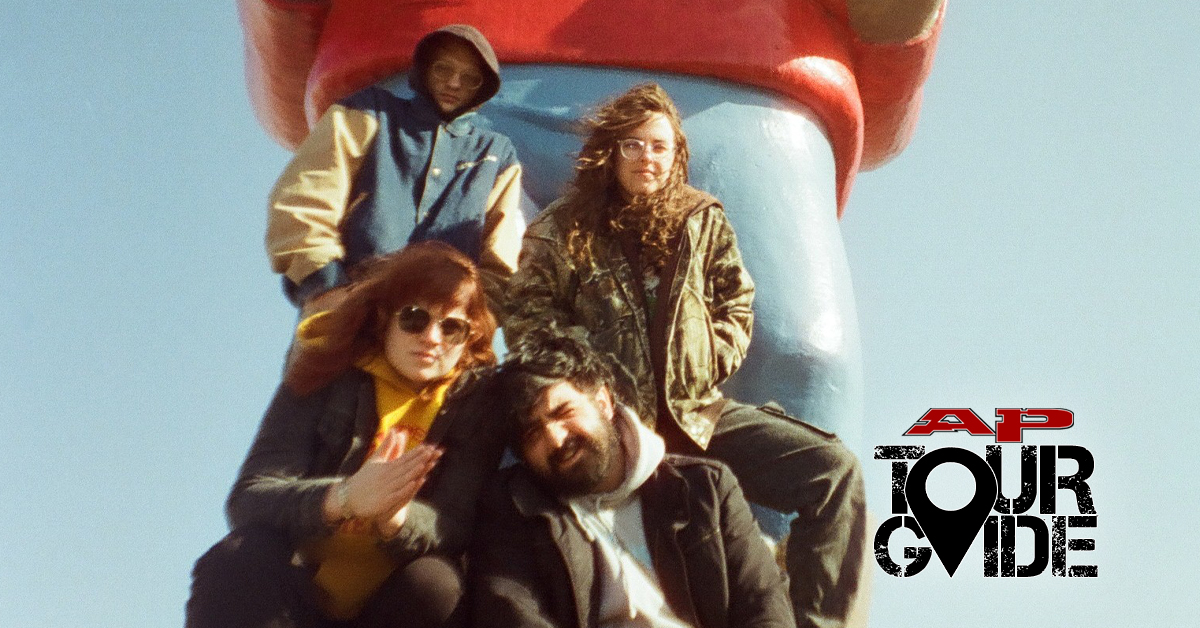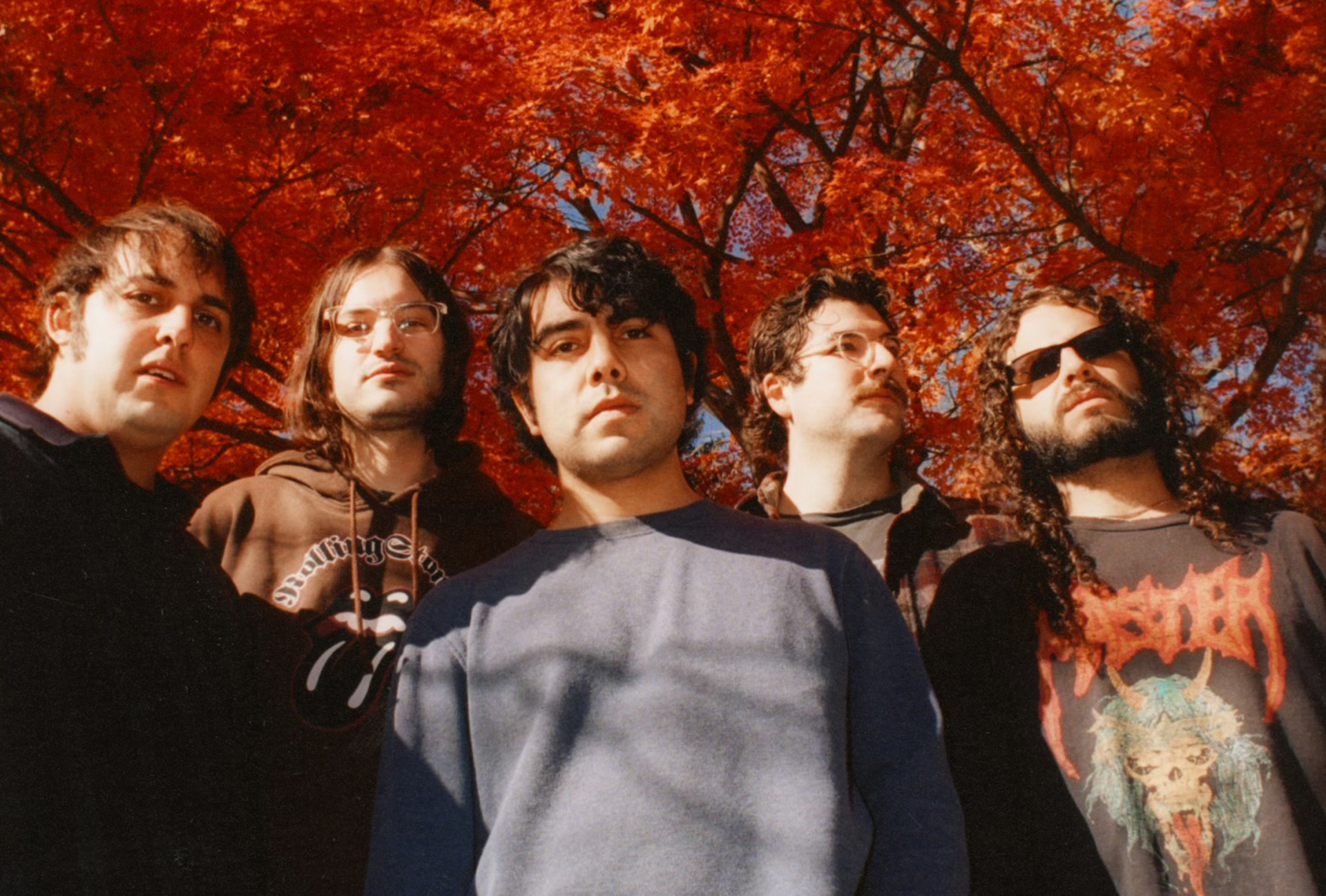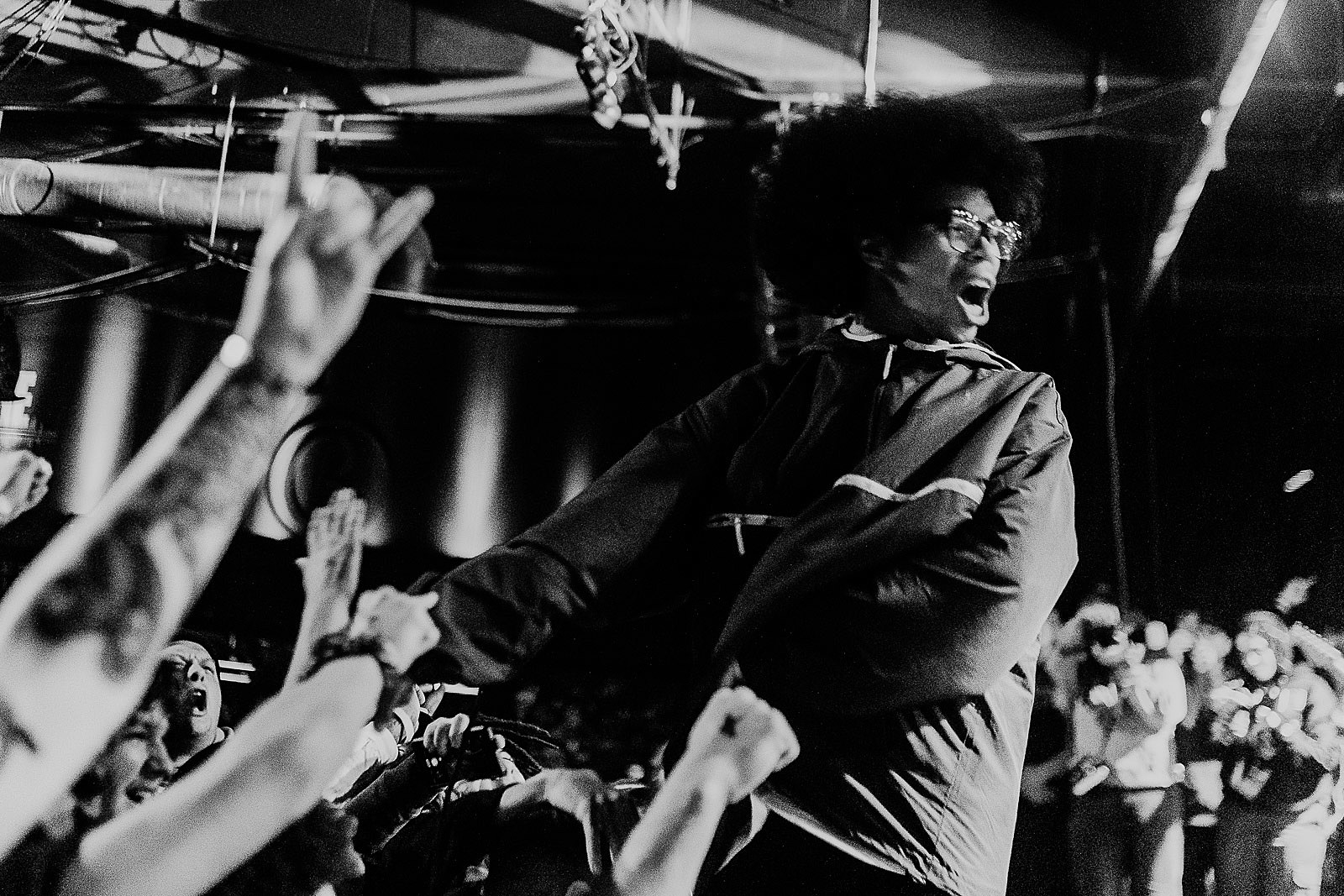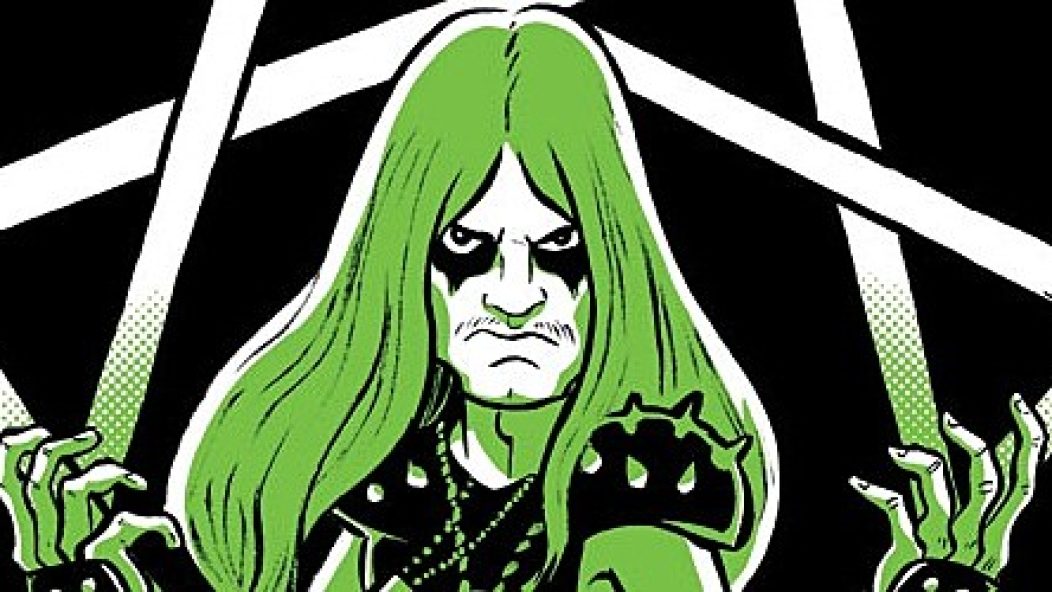
Interview: Mark Rudolph, Master Of Extreme Metal Cartoons
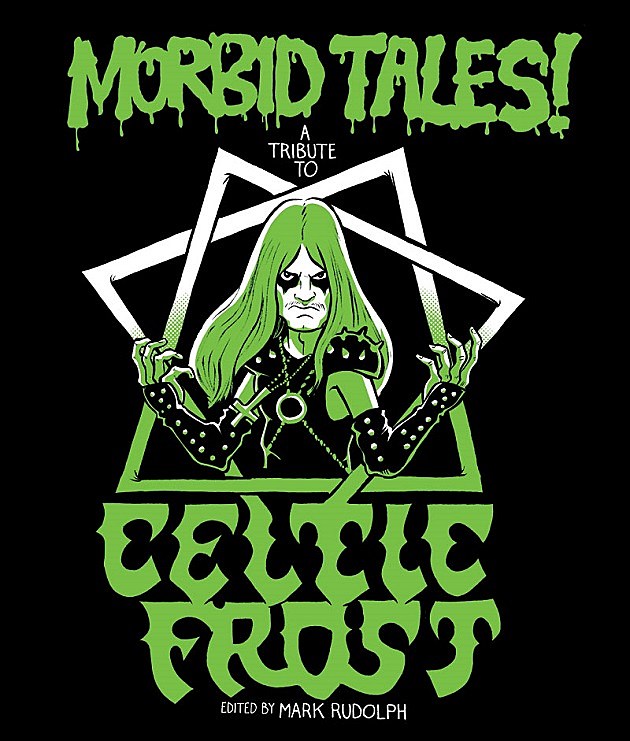
…
Anyone who has read Decibel Magazine in the past five years has seen Mark Rudolph’s art. From Nergal screaming out of a spiked hood or Joel Grind posing in front of smoking barrels of toxic waste, Rudolph’s caricatures of metal’s finest have long graced the publication’s reviews section, and his saturated collages of album covers have graced the magazine’s special issue lists of the Top 100 Black and Death Metal Albums Of All Time. But arguably more impressive than his work for Decibel is the book Rudolph edited and curated, Satan Is Alive: A Tribute To Mercyful Fate. The first collection of its kind, Satan Is Alive features artistic tributes and musician’s testimonials, perfectly merging comic art and diehard devotion in honor of the fathers of black metal.
Not satisfied with just one tribute book, Rudolph has recently announced Morbid Tales: A Tribute To Celtic Frost, part of a planned trilogy of metal tribute collections. (Check CV Comics and Corpse Flower Records for updates regarding preorders.) When Invisible Oranges contacted him, the artist was more than happy to share his love of King Diamond and MAD Magazine with us.
…
Tell me about how you first started drawing and how you first got into metal.
I’ve been drawing since I was a kid, but really got “serious” about it after my dad got me an issue of MAD Magazine in the early ‘80s. There was something about seeing actors, politicians, and public figures done in caricature that struck a chord with me. It surpassed reality in a way unlike Spider-Man or other comics I read as a child. There was that element of recognizable reality there, but it elevated it to the borderline surreal. Of course, at that age I wasn’t able to artistically understand the craft behind the caricature, but that initial meeting really guided where my artistic path would lead.
I didn’t really get into metal until my early teen years. I was listening to the radio, then going through my classic rock phase into hard rock and eventually stumbled onto Bolt Thrower’s Realm of Chaos in a local record store’s import section. That changed my life as much as MAD Magazine did. I had an immediate attraction to and connection with extreme metal.
Who influenced you growing up, both artistically and musically?
Comics have always been a huge influence on me artistically, in particular American super hero comics. ‘70s Marvel comics like Conan, Spider-Man and later G.I. Joe. But it all really comes back to MAD Magazine and EC Comics for me. Looking back, that pool of artists (Jack Davis, Wally Wood, Johnny Craig, Harvey Kurtzman, Joe Orlando, Will Elder, etc) was able to capture humor, horrific gore, and suspense in a “cartoony” style better than anyone else.
Music didn’t really inspire me much as a child until I was introduced to classical music by my folks (especially the really bombastic stuff like Wagner and the Conan the Barbarian soundtrack). Lyrics always took me out of being immersed by music. I typically digest music by drawing at the same time. It creates an energy that translates into my physical act of drawing. I remember getting lost drawing and listening to Seasons in the Abyss on auto-repeat on my walkman. Like, for hours at a time. That’s what is magical about extreme metal to me. It, unlike anything else, can transport me to another world.
There are many great artists who still have a hard time capturing human characteristics the way you do. What goes into creating a great caricature? How do you keep from going too far?
Thanks for that! Caricature is definitely a maligned art form. Most people immediately think of the guy at the fair who draws you with a huge head, but there’s another school of it altogether. Jack Davis is, in my opinion, one the most versatile and expressive cartoonists ever. He’s able to caricature the entire body and the actions of a character. It’s hard to explain, but there is a fine line that I try to not cross. As to my approach, I try and pick out the person’s most dominant characteristic (say he has a big nose) and work around that feature. Then the outside shape of the hair and head are hugely important to exaggerate without making it grotesque. Luckily, many metal bands are filled with very distinctive-looking people who make my job a bit easier.
Was there a metal musician you were asked to draw for Decibel who it was an honor to portray?
There are a few. Since my formative years were spent doing fanzines, I interviewed and did layouts for bands, but being able to draw them is a different feeling. And doing it where the artists themselves are super excited about it is the best feeling. So, Paradise Lost was one for sure. Then Carcass and Iron Maiden. All those bands are in my Top 10, so that was a super stressful, paper crumpling time working on those.
…
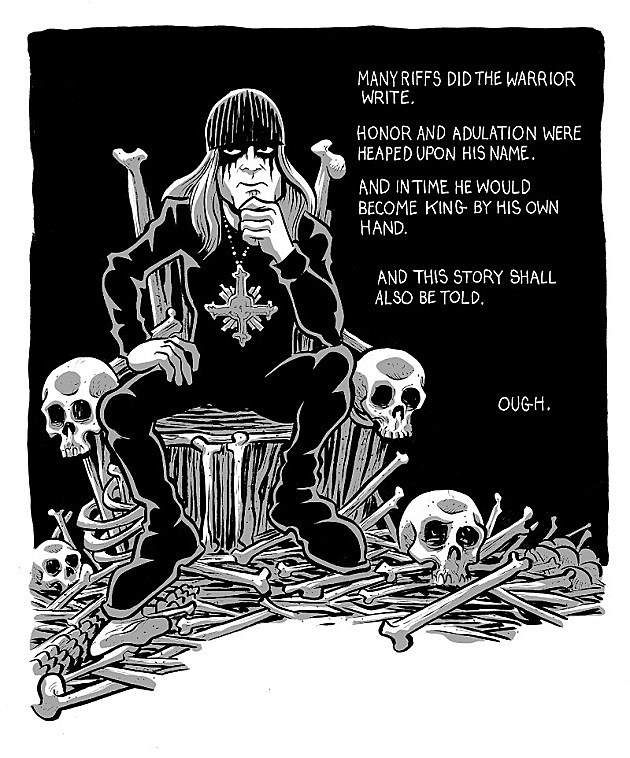
…
What’s been the most fun thing you’ve drawn for Decibel?
When Albert Mudrian approached me about doing the Death Metal Special Issue, I was beyond excited. He gave me a list of bands, and I just took bits and pieces from iconic album covers and filtered them through my style and created this collage of lepers, demons, and other atrocities. It was one of the first in a series of insanely populated pieces I’ve done. It really challenged me to push myself way beyond my comfort zone.
What’s your process like? Do you work out of a studio? Are you super-fastidious, or do you just have a beer or two and doodle?
I work out of a studio in the front of our apartment that is separate from the rest of our living space. When I was single, I’d just have my whole living room as a studio, but it made getting away from work impossible. But the process involves a lot of reference-gathering (image searches), listening to the band in question, and coming up with the initial idea. I used to do a lot more exploratory sketching, but now I go right to the page and pencil out the whole piece, constantly going back to reference material. Once I’m satisfied with the pencils, I ink on a lap board and scan the piece in and color it using Photoshop. I try to keep the digital component of my work very sparse. I feel like it’s more immersive when it’s just you and a piece of paper. Fewer distractions. And I’m more present and engaged in what I’m doing. I try and keep my work day like a nine-to-six kinda thing, so if I go later I’ll have a bourbon or three, but I try to stay somewhat coherent. I used to work completely tanked, which I wouldn’t recommend, but that’s a story for another time.
Tell us about the first tribute book you edited/curated, Satan Is Alive: A Tribute To Mercyful Fate. How’d that come about?
The Fate book came together after I finished an adaptation of H.P. Lovecraft’s Dagon. I was looking to adapt something else, but not a literal piece of writing. I remember meeting Tom Neely (Henry & Glenn Forever, The Humans) at a comics show in Minneapolis, and by that point I had just toyed around with the idea of maybe doing a short form comic about King Diamond. But if memory serves, Tom planted the seed of an anthology in my head, and it kind of blew up from there. I used all the industry contacts that I’d gathered over the years and asked a lot of favors, but it eventually became a pretty successful book (now on its second printing). It became a marriage of my two loves: metal and comics (underground of course).
Whose art in Satan Is Alive is your favorite? Did anyone surprise you?
That’s a hard one. There is so much great stuff in there. But Kim Holm (a fantastic Norwegian cartoonist) was the one that made me scrap the work I had done up to that point after seeing his. It was kinetic and expressive and its majesty completely shamed me into doing better. That’s always a great feeling—when you’re consistently working with people that challenge you to up your game.
Do you know if King Diamond or Hank Sherman have copies of the book?
A friend approached King’s publicist about him perhaps writing something for the book, and he politely declined. Which in retrospect was for the best. It became a tribute just by people that honestly love the band and had nothing to do with King’s camp. It feels more pure to me. As far as if they’ve seen the book? If they have I haven’t heard about it.
Which do you prefer, old-school long-hair leather-jacket King Diamond or modern ultra-gothic top hat King Diamond?
Classic cape, open leather vest, and mustache. I respect his evolving persona, but that first time I saw him on the cover of Kerrang! Magazine, or whatever newsstand metal rag it was, just seemed so larger-than-life to me that it stuck with me as the definitive King look.
You’ve just announced a second tribute book, Morbid Tales: A Tribute To Celtic Frost. Why Frost, of the many bands you like?
To me, Celtic Frost is one of the most important bands in the evolution of extreme metal. They didn’t let their limitations inhibit their creativity—actually, quite the opposite. Those limitations are what shaped those early records. Simple, catchy riffs. Really creative vocal phrasing and undeniably original visuals. They took what Venom started and took it so much further into the cerebral and weird, without ever losing that great songwriting. There was also that crossover factor. Punk, metal, and goth fans all loved Frost. They pulled in the rawness of punk, the speed and power of metal and the doom and gloom (and sometimes vocal stylings) of goth music. They are a band that always did whatever they wanted, often to the disdain of fans and critics, but I enjoy all eras of Frost. Cold Lake, while uneven, has some really great riffs and weird fucking vocal lines on it, and Vanity/Nemesis is an all around great record. It’s a shame it’s never culled for live material nowadays. I understand why Tom G. doesn’t want to relive that part of Frost’s career, but I deeply respect his creative vision/path, no matter how diverse it was. If you look back at all the projects I’ve done, there are a lot of inconsistencies, but I wouldn’t be where I am now without making some of those sidesteps.
…
…
Mercyful Fate have a very recognizable aesthetic—that sort of Hammer Horrror Satanism. What would you say is Celtic Frost’s aesthetic?
I think it’s metaphysical and otherworldly. Like a dimension of inner turmoil that Frost is the conduit into. I think H.R. Giger is an important component of how I see them, too. The To Mega Therion cover is a masterpiece and instantly recognizable as both Giger and Frost. Although one is visual and the other musical, they share the same DNA. So for artists to interpret those feelings in the book, it’s not as much an aesthetic (as the Fate book was), but more of a mindset. The art and stories told in the book are all wildly different, some humorous, some contemplative, some a wild acid trip. But it all makes sense in the context of Morbid Tales!
Who are some artists contributing to Morbid Tales? What about forewords by musicians?
This time around we have work from Justin Bartlett, Jason McGregor, Bruno Guerriero, Lars Krantz, Chuck BB, Shawn Knight, J. Bennett, Eamon Espey, Ed Luce, Jeremy Baum, Johnny Ryan, Josh Bayer, Jacob Hamrick, J.T. Dockery, Kelly Larson, Kim Holm, Michael Hacker, Mike Erdody, Slasher Dave, Tim Shagrat, Mark Rudolph, Sam Wolf, Tim Sievert, Mark Thompson, Scott Murphy, David Liljemark, Kevin Cross, Rob Millsand, and a few others to announce soon.
There are forewords from Tomas Lindberg (At The Gates) and Ivar Bjornson (Enslaved), with other pieces from Joel Grind (Toxic Holocaust), Flo Swartz (Pyogenesis), Ben Ash (Carcass), Scott Kelly (Neurosis), Fenriz (Darkthrone), Dan Lilker (Brutal Truth), Jeff Wagner (author of Mean Deviation), Shane Embury (Napalm Death), Greg Macintosh (Paradise Lost), Trevor Peres (Obituary), Scott Carlson and Matt Olivo (Repulsion), Orvar Safstrom (Nirvana 2002), Attila Csihar (Mayhem), Chris Reifert (Autopsy), and John Paradiso (Evoken). It’s a great mixture of musicians and artists.
And I’m partnering With Kenneth McNabb at Corpse Flower Records (a new vinyl only label) to produce the book and a limited edition LP of covers (to be announced soon) to be released later this year.
Are there any plans for a third tribute book? What band would it be about?
There is another one (gotta make it a trilogy) that I have in mind. I see these artists as three pillars of the extreme metal scene, at least from my perspective, and think I should end it there. But I have many other metal-related ideas in mind for future books. I’ll let people speculate about the next book. I like to have these almost finished before announcing anything about them. I don’t want to inundate people with so much of the book that there is no point reading it.
…






